Many Have the Will but Still Seek a Way to Save Orangutans
- Share via
According to an atlas, it’s roughly 10,000 miles from Southern California to the nearest orangutan living in the wild.
But that didn’t deter a crowd from packing a lecture hall at Cal State Long Beach on Saturday for a daylong conference on the great apes, their behavior and what can be done to save them.
Orangutans are native only to the islands of Borneo and Sumatra in the Southeast Asian nations of Malaysia and Indonesia. Their populations have plummeted in the last century.
Some estimates hold that there are at least 18,000 orangutans in the wild, but the apes are being squeezed by a variety of pressures, most notably the loss of their habitat to logging and agriculture, and poaching.
Though the problem is half a world away, there is no shortage of primatologists and anthropologists in Southern California interested in the apes.
“Conservation is driving it, but it’s also that so many schools today are teaching courses in primate behavior, and students love it. The primates are a window into ourselves,” said Norm Rosen, a Cal State Fullerton anthropology professor and the head of the Southern California Primate Research Forum.
The group sponsors daylong conferences on various primate issues twice each year at campuses in Southern California. Money from ticket sales helps bring experts from across the globe to speak.
Orangutans are the only great ape found in Asia; gorillas and chimpanzees are found in Africa. Like those other species, orangutans are considered very intelligent. But they also need vast expanses of habitat and are slow to reproduce -- much like grizzly bears and mountain lions in North America.
Echoes of familiar arguments from the Northern Rockies about persuading people to save unbroken chunks of grizzly habitat could be heard in the lecture of Willie Smits, an ecologist and founder of the Balikpapan Orangutan Society, which works to save habitat in Borneo and Sumatra.
“Today I won’t speak much about orangutans, but I will speak about the forest,” said Smits, who said the key is to show people how to make a living without destroying the forest.
Others spoke of the need to learn more about how orangutans think and behave -- before they disappear from the wild.
“Of all the great apes, orangutans are the least understood in terms of behavior and cognitive abilities,” said Robert Shumaker, a researcher who is helping build the Iowa Primate Learning Sanctuary in Des Moines.
Shumaker has been studying orangutans at the National Zoo in Washington, where he has learned to communicate with the apes by having them point to symbols on a computer screen.
It’s not, he said, simply a matter of teaching an animal a neat trick. Rather, it’s a way to show people how intelligent the orangutans are and convince people they should be saved.
“The apes are our closest living relatives,” Shumaker said. “I think that confers a level of respect and a special set of responsibilities for the great apes.”
Shumaker is a pro when it comes to research. But the conference also attracted those who wish to become the next generation of scientists in the field.
Emilie Kissler, who is 23, traveled to the conference from Guelph, Canada, to make a small presentation on a question that has been gnawing at her:
Are there certain plants that orangutans eat only for their medicinal value? And, if so, did the native Dayak people in Borneo learn that trick from the apes?
Kissler, who is shopping around for a graduate program, realizes she faces years of research. She’ll need skills in toxicology, chemistry, wildlife behavior, nutrition and biomedicine and will have to battle other scientists for funding while working thousands of miles from home.
So why do it?
“I’ve never liked working inside,” she said.
More to Read
Sign up for Essential California
The most important California stories and recommendations in your inbox every morning.
You may occasionally receive promotional content from the Los Angeles Times.













